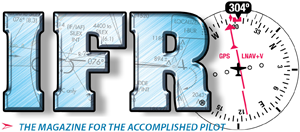While most swans that we see have white feathers, black swans do exist. In 2007, Nassim Nicholas Taleb published a book titled Black Swan. He described a “Black Swan Event” as an unforeseeable event that goes beyond what is expected with potentially dire consequences, with a very low probability of happening, and one that we typically cannot forecast. While the context of the book was mainly focused on finance and general macroeconomic events, the concept has a widespread applicability—especially in aviation risk management. Think of it as something so far out there, we don’t even think about it, like a wing falling off, or complete loss of GPS navigation.
MON Requires VOR Skills
My colleague Fred Simonds wrote a very interesting article on “Backing up GPS” in January where he covered the FAA’s Minimum Operational Network (MON). MON has several components; the main one is the shutting down by 2025 (a very optimistic deadline) of about a third of the existing VORs due to age and associated maintenance costs. Additionally, the widespread prevalence of GPS for primary navigation seems to imply that VOR navigation (and ILS approaches) might soon join the dustbin of obsolete navigation systems such as Loran-C, the four-course range, VLF-Omega ,and Columbus’ astrolabe.
But there is another aspect of MON. While GPS consists of a constellation of satellites with orbiting back-up satellites, GPS as a system is considered a single point failure whereas VORs, as a whole, are not.
What can cause GPS to fail or not be available? Since it is controlled by the US Department of Defense (DoD), the Department can shut down GPS for civilian use due to national security considerations. Or there might be atmospheric disturbances, terrorist acts, or just random failures.
GPS outages have at least two dimensions: outage duration and extent (widespread or regional). But when there is an outage, especially a widespread outage that lasts several weeks, I would consider it a Black Swan event I’ll call the GPS Black Swan. This is a highly improbable event with severe impacts not only to aviation but our very infrastructure. But, as aviators, we need to ask ourselves, “How would this affect my flying?”
MON Airports
Before considering the impact of the GPS Black Swan, the FAA has identified “MON airports.” They are depicted on low and high en-route charts and listed in the Chart Supplements. The idea behind these MON airports is that you’ll always be within 100 NM of a general aviation airport in the lower 48 states that has a ground-based approach, preferably an ILS. Additionally, an approach to a MON airport will not require DME, ADF or radar vectors. Further, you’ll be able to reach such airports using VORs when at or above 5000 feet AGL. Thus, the MON airports will allow a VOR and ILS-equipped aircraft to safely navigate to an airport and fly an approach, all without RNAV.
Will your skills permit you to do that?
Skills Lost Through GPS
This article stems from a virtual water-cooler discussion amongst various Belvoir editors and contributors. As we were discussing the MON environment, we began to wonder if today’s pilots—ourselves included—actually have sufficient skills to safely handle a loss of GPS. I shared some of my experiences as a CFII, and the conversation gradually shifted to lost skills, mostly due to reliance on GPS. Here’s an incomplete list. See where, or if, you fit.
Moving Maps Today it is common in our technically advanced aircraft for us to ask, “Why is it doing that?” when we observe our FMS-coupled autopilot doing what it was told, but not at all what we expected. Years ago, we might wonder “Where are we?” as we were temporarily lost when flying over featureless terrain. I remember it was a common, almost daily event for pilots to get “lost” over the Florida Everglades only to be saved by a DF (direction finding) steer from a nearby FSS (Flight Service Station). That was before VFR pilots talked to radar controllers. All student pilots were told to use the Everglades Reporting Service that required VFR position reports every 10 minutes. That service is now gone.
Most (all?) instrument pilots use moving maps, whether a portable, or a panel-mounted display. I think we would all agree that moving maps have greatly increased safety through enhanced situational awareness. Moving maps might also have decreased the number of CFIT (controlled flight into terrain) accidents. They also instill confidence as we verify our track on approach.
We all know that it’s inappropriate to actually navigate using the moving map, steering to keep the little airplane on the desired track line. Instead, you properly use the navigation instruments designed for that task. Nonetheless, we need to ask if we’re comfortable flying without a moving map. If you aren’t, you’ve lost a fundamental skill that is required of all instrument pilots.
Of course, just because you lose your moving map, doesn’t necessarily mean you won’t be able to display a static electronic map on your EFB. Could you navigate with that, or even using—gasp!—paper charts (if you even have them)?
Tune and Identify the Station Recently, I had an instrument student who was flying well, just about ready for his checkride. We decided to fly one more ILS before the practical. The approach was loaded into the navigator; we were being vectored onto the localizer; everything seemed in order. But, as we were nearing the LOC course the needles didn’t look right. As a mischievous “double-II,” I grinned, deciding to wait to see what happened.
Nothing happened. Why? Because the LOC frequency hadn’t yet been flip-flopped into the active frequency window. Our GPS-nav paradigm doesn’t require fiddling with the radios to keep navigating, so we often overlook the lost art of tuning VOR, LOC, even ADF, and DME frequencies, and then identifying the station.
Many modern radios will decode the Morse code of the station and display it. If you have one of those, you need not check the identifier yourself (per AIM 1-1-3). But, you still need to verify the decoded identifier to make sure it’s both 1) there, and 2) the right one.
If your radio doesn’t have that capability, you need to check the station identifier yourself, and unless you know Morse code, look up the “dots” and “dashes” on the charts to positively identify the station. Also, remember that all LOC identifiers start with the letter “i” as in ILS. If you’re not doing any of this now, perhaps you should start, just to stay in practice.
Navigating with VOR Who wouldn’t prefer to use GPS for en-route navigation instead of VOR? In general, GPS is much more stable compared to the common scalloping of VOR signals that makes the needles dance. (Side note: Modern digital VOR receivers are nearly immune to the scalloping of the signals, and the CDI is quite stable.) The big advantage of GPS, of course, is that it allows shorter routes, “direct to” a distant waypoint.
Additionally, VOR navigation is TO–FROM with station passage as compared to GPS which is usually TO-TO navigation. Then, there’s the need to tune and identify the next VOR, either at the midpoint or the charted changeover point.
You remember all this, right? That’s nice in theory, but try proving to yourself you can still do it by using only VOR navigation on your next trip.
This has nothing to do with lost GPS, but seems to be a lost skill. When I was flying for the airline, we served a few non-towered airports. Typically, there was a remote communications outlet (RCO) on the field so we could reach FSS, but we even had to occasionally use the old-school method of calling on one frequency and receiving on the nearby VOR frequency.
While in the air, airline pilots usually switch legs, alternating who will be pilot flying and who will be pilot monitoring and working the radios. But, at our airline, on the ground the first officer (FO) was always pilot monitoring. Of course, being an old dog, all of my FOs were kids by comparison. Not disparaging—they were all excellent pilots.
But, in the years I was there, not one of them knew how to properly contact FSS. Not one. It actually got to the point where as part of our approach briefing going into a non-towered airport, I’d explain it to them: First, identify the frequency or frequencies in use and set up accordingly. Determine who you’re calling. Then, listen for a good minute before transmitting; FSS specialists work dozens of frequencies and you want to make sure it’s clear. Then, make your initial call, with only your identification but nothing to do with your request, making sure to tell them where and how you’re listening. “Denver Radio, Airliner 1234, listening on the Outback Airport RCO.”
Only after you’ve established communications like that can you complete your transaction. But, you knew all that, right? —Frank Bowlin
VOR Accuracy Checks If we have a VOR and we use it for IFR navigation, we need to do that 30-day accuracy check. You never know when you might need to use a VOR, so it’s best to keep those checks current, or at least do one early on each trip. With dual bearing pointers common with EFIS, the check is easy. Tune the same VOR station in both NAV receivers, if the pointers overlap, then they meet the accuracy standards. Just don’t forget to document the check according to §91.171: “… date, place, bearing error, and sign the aircraft log or other record.”
But some GPS navigators don’t have VHF nav, meaning that some aircraft might have only one VOR. In this case, a VOR check is a bit more complicated requiring checkpoints either published or of our own determination. Note that if your new panel eliminates VORs altogether, you likely won’t be able to navigate (other than pilotage or dead reckoning, speaking of lost arts) if a GPS Black Swan Event occurs.
ILS (and VOR) Approaches Flying an RNAV approach is easy: load the approach and follow the magenta needle to the final approach course (FAC), down the FAC, and on the missed. No knob twiddling needed, unlike a ground-based ILS or VOR approach.
Using an all-in-one navigator like the ubiquitous GNS 430 or its more modern GTN brothers, we’ve come to rely on that GPS, even for ground-based approaches. For example, if you’re going to fly an ILS, what’s the first thing you do? Load the approach. Why do that? It’s for situational awareness so the fixes on the approach are on your flight plan and on the moving map. But, what if you have no GPS signals? Then, there’s no point in loading the approach, right?
Using your navigator, could you set up and fly a ground-based approach manually, without plugging it into the GPS flight plan? Try it sometime. Here are the basic steps, and we’ll be gentle by not throwing in a procedure turn:
- Brief the approach, noting how you’re going to get from the VOR-based en-route environment to the IAF and onto the FAC.
- Set up your nav, probably putting the feeder route you found above into #2, if you have two, and the ILS into #1. Tune and identify the stations, noting that you might not yet receive the LOC. Don’t forget to manually set the OBS to match your desired course(s). The process is the same with only one nav, but there’s a lot more tuning and twisting.
- Once you’re on that feeder, again review your navs. Have you done everything? If you’re single nav, have the ILS frequency in the standby.
- As you approach the turn to the FAC, make sure you’ve already tuned and identified the ILS (actually the LOC) and set the OBS correctly. It gets busy here if you’re single nav, but it’s all possible. Switch to the ILS for your nav as you make the turn to the FAC.
- As you track the FAC, get set up for the missed. On #2, you can now tune and identify the VOR you’ll need for the miss and set the OBS. If you’re single nav, at least put the frequency in the standby window.
- Once on the miss, switch to the nav for that, presumably following #2, if you have two. If you don’t, you’ll have to switch frequencies, change the OBS, and identify the station. Oh, yeah. Keep flying.
- Chances are that your missed approach holding fix will require a crossing radial. Tune (frequency, identifier, radial) for that. If you only have one nav, well, good luck with all the time, tune, turn, twisting.
It’s likely been a while (a long while?) since you’ve done all that. Might be worth a little practice, eh?
Conclusion
While a GPS Black Swan Event requiring MON is highly unlikely, since MON is the design goal the FAA has in mind, we should maintain our skills using VORs, flying without a moving map, and flying a ground-based approach without GPS. We once learned to do all that; let’s keep those skills sharp.
Perhaps engage a friendly CFII and get some practice. You might even try a few under VFR on your own first. Maybe consider flying profiles that simulate the above. If there is a MON airport nearby, fly the approach (ILS or VOR) including a procedure turn and missed approach as published. Do it “old school” without a moving map.





